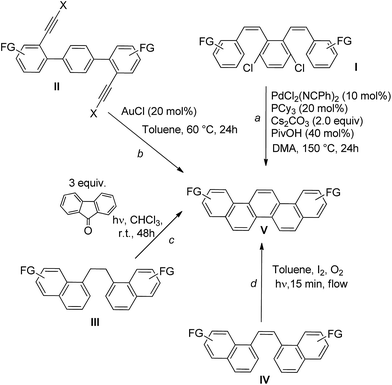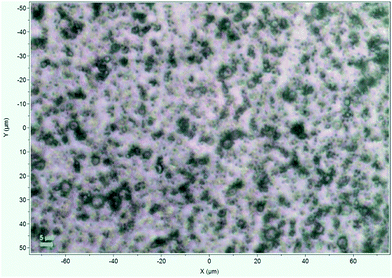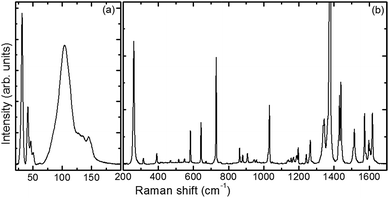 Open Access Article
Open Access ArticleCreative Commons Attribution 3.0 Unported Licence
Preparation of (substituted) picenes via solar light-induced Mallory photocyclization†
Stefano
Protti
a,
Gianluca A.
Artioli
b,
Francesco
Capitani
c,
Carlo
Marini
d,
Paolo
Dore
c,
Paolo
Postorino
c,
Lorenzo
Malavasi
b and
Maurizio
Fagnoni
*a
aPhotogreen Lab, Department of Chemistry, V. Le Taramelli 12, 27100 Pavia, Italy. E-mail: fagnoni@unipv.it; Fax: +39 0382 987323; Tel: +39 0382 987198
bDept. of Chemistry and INSTM, University of Pavia, Viale Taramelli 12, I-27100, Pavia, Italy
cDipartimento di Fisica, Sapienza Università di Roma, P.le Aldo Moro 2, 00185 Roma, Italy
dEuropean Synchrotron Radiation Facility, BP 220, 38043 Grenoble Cedex, France
First published on 12th March 2015
Abstract
Picenes 2a–c were readily obtained via photocyclization of dinaphthylethenes 1a–c by a straightforward solar light-induced Mallory reaction. The product was easily recovered by simple filtration after exposure of the reaction mixture to sunlight. The polyene obtained was then characterized by means of Raman spectroscopy and X-ray diffraction.
Introduction
Organic molecular systems with extended π-conjugation have attracted attention because of their potential use in organic electronic materials.1 In particular, semiconducting polycyclic aromatic compounds, such as pentacene and anthracene, have been used in organic field-effect-transistors (FETs) due to their mechanical flexibility, light weight, low cost and environmental stability.2 In general, pentacenes are employed in the preparation of the active layers of p-channel thin film FETs with high mobility values (μ ca. 1 cm2 V−1 s−1).3,4For analogous reasons, organic molecules have been objects of intense research in the field of superconductivity. Early evidences have been obtained with tetraselenafulvalene5 and tetrathiafulvalene6 derivatives. However, the most striking discovery related to C-based organic superconductors was that of Mitsuhashi and co-workers in 2010, who reported a critical temperature (Tc) as high as 18 K by K-intercalation of the hydrocarbon picene (C22H14). This was the first example of a molecular superconductor in which the organic component contains only C and H atoms and it led to a huge revitalization of the field of superconducting π-electron materials and of superconductivity in general.7
Following the discovery of superconductivity in metal-doped picene, researchers faced the problem of having organic molecules of this type available in high purity and large scale. As a matter of fact, the development of a synthetic protocol for the synthesis of (substituted) picene (V, Scheme 1) is currently a challenge. For this aim, different approaches (either metal-catalyzed or photochemical) have been devised for this target;8–10Scheme 1 summarizes the most recent ones. The first route involved a Pd-mediated intramolecular cross-coupling of 2,3-bis[(1Z)-2-phenylethenyl]benzene I at a high temperature (150 °C) with the concomitant formation of two Ar–Ar bonds (path a).8 Milder conditions were adopted in the gold catalyzed conversion of substituted terphenyl II (path b).9 In the latter cases the reactions were carried out on a small scale in yields up to ca. 50%.8,9 There is, however, a great interest in the use of photochemical reactions for the straightforward preparation of polyaromatic compounds such as helicene or helicene-like derivatives.11,12 As an example, Kubozono and his coworkers recently developed the photosensitized (by 9-fluorenone) conversion of 1,2-dinaphthylethane III to picene albeit in a poor yield (19%, Scheme 1, path c).13 The most promising route, however, is E/Z isomerization followed by oxidative photocyclizations of stilbenes (the so-called Mallory reactions).14 Accordingly, differently substituted picenes V were formed upon irradiation of 1,2-naphthylethenes IV in the presence of iodine and oxygen (path d), and the process can also be carried out under flow conditions in a very short time (residence time = 6 min).8c,15
The latter photochemical reactions, however, suffer from the use of artificial light, e.g. by requiring a high-pressure Hg arc lamp. The use of solar light in photochemical processes is obviously desirable to improve eco-sustainability and, at the same time, minimize the energetic expenditure of the process.16 Accordingly, the aim of this work was to develop the first straightforward sunlight induced synthesis of (substituted) picenes by optimization of the Mallory cyclization.
Results and discussion
We preliminary focused on the preparation of picene 2a. Diarylethene 1a was synthesized in a E/Z mixture by a Wittig condensation between naphthylaldehyde and (naphthylmethyl)triphenylphosphonium salts.17 The photocyclization step was optimized by varying the reaction conditions as illustrated in Tables 1 and 2. Initially, we chose benzene as the reaction medium, since it is reportedly one of the preferred solvents for the photocyclization reaction.14 We tested the effect of the amount of iodine and oxygen on the reaction. As apparent from Table 1, the photolysis of oxygen-saturated solutions gave consistently better results than those that were air-equilibrated and a nearly quantitative yield of 2a was achieved by increasing the [I2] up to 15% w/w. In each case, the product precipitated out from the solution and the yields were determined only by weighing the separated solid (Table 1). The purity of the picene 2a did not differ substantially from that purified by sublimation, as was apparent from NMR analyses (see ESI†).| 1a, M | I2, %w/w | 2a, Picene, % yield |
|---|---|---|
| a Conditions: a 20 mL oxygen-saturated solution of 1a in C6H6 irradiated at 310 nm (10 × 15 W lamps) for 16 h in a test tube. The yields were determined from the solid picene precipitated out after irradiation. b Air equilibrated solution. | ||
| 0.019b | 3.5 | 29 |
| 0.019 | 3.5 | 80 |
| 0.019b | 7 | 53 |
| 0.019 | 7 | 82 |
| 0.019b | 15 | 57 |
| 0.019 | 15 | 93 |
| Entry | 1, M | Solvent | Light source | t irr (h) | Picene, % yield |
|---|---|---|---|---|---|
| a Conditions: a 20 mL oxygen saturated solution of 1a in the chosen solvent irradiated at 310 nm (10 × 15 W lamps) for 16 h in a test tube. b Irradiation carried out in a solar simulator (SolarBox) on a 10 mL volume placed in a Pyrex glass vessel. c Picenes 2a–c isolated by simple filtration of the end mixture. d Reaction carried out on 1 gram of 1a (100 mL solution). e Irradiation by sunlight for 3 days (6 h per day). f Picene 2c purified by column chromatography. | |||||
| 1 | 1a, 0.019 | C6H6 | 310a nm | 16 | 2a, 93 |
| 2 | 1a, 0.019 | Toluene | 310a nm | 16 | 2a, 40 |
| 3 | 1a, 0.019 | C6H5CF3 | 310a nm | 16 | 2a, 55 |
| 4 | 1a, 0.019 | Acetone | 310a nm | 16 | 2a, 46 |
| 5 | 1a, 0.019 | CH2Cl2 | 310a nm | 16 | 2a, 55 |
| 6 | 1a, 0.019 | CHCl3 | 310a nm | 16 | 2a, 63 |
| 7 | 1a, 0.019 | C6H12 | 310a nm | 16 | 2a, 75 |
| 8 | 1a, 0.019 | Ethyl acetate | 310a nm | 16 | 2a, 75 |
| 9 | 1a, 0.019 | C6H6 | SolarBoxb | 8 | 2a, 77c |
| 10 | 1a, 0.019 | Ethyl acetate | SolarBoxb | 8 | 2a, 80c |
| 11 | 1a, 0.038 | C6H6 | SolarBoxb | 8 | 2a, 72c |
| 12 | 1a, 0.038 | Ethyl acetate | SolarBoxb | 8 | 2a, 81c (70c,d) |
| 13 | 1a, 0.057 | C6H6 | SolarBoxb | 8 | 2a, 20c |
| 14 | 1a, 0.038 | C6H6 | Sunlighte | 18 | 2a, 69c |
| 15 | 1a, 0.038 | Ethyl acetate | Sunlighte | 18 | 2a, 72c |
| 16 | 1b, 0.038 | C6H6 | SolarBoxb | 10 | 2b, 60c |
| 17 | 1b, 0.038 | Ethyl acetate | SolarBoxb | 10 | 2b, 68c |
| 18 | 1c, 0.038 | C6H6 | SolarBoxb | 10 | 2c, 71c |
| 19 | 1c, 0.038 | Ethyl acetate | SolarBoxb | 10 | 2c, 54f |
Different media were then tested in order to find safe alternatives to benzene for the reaction (Table 2). Again, the yields reported are those measured by weighing the solid picene formed. Other aromatic solvents (toluene and α,α,α-trifluorotoluene) however, gave picene in lower yields (40–55%, entries 2–3). Similar results were obtained with medium polarity solvents such as acetone, chloroform and methylene chloride (46–63% yield, entries 4–6). Results comparable to those observed with benzene were obtained with cyclohexane and ethyl acetate (75% yield of 2a, entries 7–8). Benzene and the more eco-sustainable ethyl acetate were then used for the remaining investigations, in which either a solar simulator or sunlight was used as the irradiation source and a Pyrex glass vessel as the photochemical reactor (Fig. 1).18,19
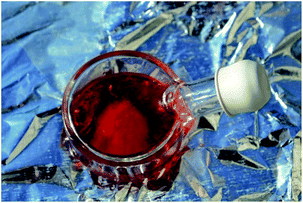 | ||
| Fig. 1 Pyrex glass vessel (20 mL capacity) used for the sunlight synthesis of picenes 2a–c. As shown, the product precipitated out upon prolonged exposure to solar radiation. | ||
As shown in Table 2, shifting to simulated sunlight did not affect the overall yield of 2a, nor did an increase of [1a] up to 0.038 M (entries 11–12). In the latter case, a good yield was likewise observed (70%) when the reaction was repeated on a bigger scale (1 gram of 1a) by irradiating a 100 mL ethyl acetate solution in a larger Pyrex glass vessel. A detrimental effect was found when the concentration of stilbene 1a was increased up to 0.57 M (entry 13). The optimized conditions found in entries 11–12 were thenceforth adopted for irradiation under natural solar light. Photochemical reactions were performed by placing the glass vessel on a window ledge of the Department of Chemistry of the University of Pavia in July 2014. Complete consumption of stilbene was achieved after three days (18 h overall) irradiation and satisfactory yields were obtained in both of the solvents tested (entries 14 and 15).
Diarylethenes 1b (E/Z 50![[thin space (1/6-em)]](https://www.rsc.org/images/entities/char_2009.gif) :
:![[thin space (1/6-em)]](https://www.rsc.org/images/entities/char_2009.gif) 50) and 1c (E/Z 70
50) and 1c (E/Z 70![[thin space (1/6-em)]](https://www.rsc.org/images/entities/char_2009.gif) :
:![[thin space (1/6-em)]](https://www.rsc.org/images/entities/char_2009.gif) 30) were then prepared and irradiated in benzene and ethyl acetate in the SolarBox apparatus for 10 h (entries 16–19). 5-Methylpicene 2b and 5-methoxypicene 2c were formed in benzene in 60% and 71% yield, respectively and, as for 2a, the product was recovered by simple filtration. The reaction was effective likewise in ethyl acetate although 2c did not precipitate out at the end of the reaction and it was purified by column chromatography.
30) were then prepared and irradiated in benzene and ethyl acetate in the SolarBox apparatus for 10 h (entries 16–19). 5-Methylpicene 2b and 5-methoxypicene 2c were formed in benzene in 60% and 71% yield, respectively and, as for 2a, the product was recovered by simple filtration. The reaction was effective likewise in ethyl acetate although 2c did not precipitate out at the end of the reaction and it was purified by column chromatography.
Raman spectroscopy and X-ray diffraction analyses were then carried out on a portion of picene 1a purified by sublimation. A micro-photograph (50× objective) of a picene sample gently pressed between two glass slides and back-illuminated is shown in Fig. 2. Whitish areas consist of assemblies of grains smaller than 1 μm, while darker regions are characterized by the presence of larger grains. Using a set of optical filters, preliminary Raman measurements were carried out by varying the laser power impinging on the sample surface to avoid sample degradation and to check possible sample heating.20 Owing to the transparency of picene grains, neither degradation nor detectable sample heating was observed even with the highest laser power. We collected data from different points of the picene samples without observing any detectable difference in the Raman spectra, a result that indicates high sample homogeneity, at least on the micrometer scale. A polarization analysis of the Raman spectrum carried out on several points of the sample did not show significant variation of the Raman peak intensities thus showing the absence of highly oriented crystals.
A representative Raman spectrum of solid picene at ambient conditions is shown in Fig. 3. The spectrum is background-subtracted and it is presented over two spectral ranges, 20–200 and 200–1700 cm−1. All the measured spectroscopic features are in excellent agreement with previously published experimental and theoretical Raman data on picene.21–23
These studies make it possible to easily assign the peaks in Fig. 3a to intermolecular vibrational modes (or lattice phonons),21 whereas the peaks in Fig. 3b, are assigned to intramolecular vibrational modes.22,23 The low frequency region (Fig. 3a) is dominated by vibrations involving the relative motion of molecules, such as translations and librations, and are thus more directly related to the overall lattice structure. The 200–1000 cm−1 spectral range (Fig. 3b) is characterized by both out-of-plane and in-plane intramolecular modes, whereas only in-plane modes can be found between 1000–1700 cm−1 (Fig. 3b). An exhaustive assignment of the observed Raman peaks was presented previously,22 along with a discussion of infrared measurements. In summary, our spectroscopic analysis does show the high quality of picene samples and a complete absence of any impurity detectable by Raman investigation.
The X-ray powder diffraction pattern of picene at ambient conditions is shown in Fig. 4. Experimental data were analyzed by means of a Le Bail fitting procedure based on the monoclinic P21 unit cell described elsewhere.24,25 The final unit cell parameters obtained are: a = 8.614(6) Å, b = 6.104(6) Å, c = 13.62(2) Å, β = 93.45(7)°, which are in good agreement with previously reported structural data.24,25 In addition, the XRD peak profiles indicate good crystallinity of the prepared picene.
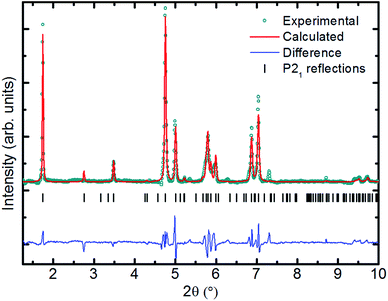 | ||
| Fig. 4 Le Bail profile fitting results of the X-ray diffraction pattern of picene powder. The background was subtracted after the fitting process. The wavelength is 0.4129 Å. | ||
Within the framework of the development of new carbon based superconductors, a straightforward and eco-friendly preparation of polycyclic aromatics is mandatory. The photochemical approach having recourse to the Mallory or Mallory-type reactions is a valid tool for the mild metal-free formation of Ar–Ar bonds via a photocyclization process.11,12 Although it is widely accepted that the reaction is initiated by the cleavage of the I–I bond in visible light absorbing iodine, the use of sunlight (an inexhaustible energy source) for this purpose has rarely been adopted.14a This work clearly demonstrates that solar radiation is the ideal energy source for this type of photocyclization, and it can be accomplished in a very simple manner by exposing the solution (placed in an inexpensive glass vessel) to ambient light on a window ledge.
In conclusion, the proposed approach allows for the preparation of gram quantitites of picene (the product can be easily recovered by filtration) with no artificial energy consumption. Importantly, the yields of picene obtained are significantly higher than those from other photochemical approaches, such as the fluorenone-photocatalyzed synthesis of picene proposed by Kubozono et al.13 As hinted above, the Mallory reaction has been recently applied to the multigram synthesis of variously substituted phenacenes (including substituted picenes) under continuous flow conditions. However, the process requires highly dilute conditions (down to 10−3 M of the starting stilbene)8c and a 450 W high pressure Hg arc lamp as the light source. The approach reported herein allows the use of a higher concentration of the substrate (up to ca. 0.04 M) in non-renewable (benzene) but likewise in eco-friendly (ethyl acetate) solvents, using a renewable energy source (the sun), thus significantly reducing the production of waste and CO2 emissions. Furthermore, the process optimization and scale-up could be improved and the reaction times shortened, by means of solar concentrators.16b
On the other hand, the use of a poorly atom-economical (% AE = 40–50%) Wittig condensation26 for the synthesis of stilbenes 1 remains a limitation to the development of an efficient photochemical route to picenes and phenacenes in general. The experimental techniques employed demonstrate the high quality of the picene crystals obtained through our novel synthetic route, with a complete absence of any detectable impurity.
Experimental
General information
1H and 13C NMR spectra were recorded on a 300 MHz spectrometer (Bruker, UltraShield™ 300). Attributions were made on the basis of 1H and 13C NMR, as well as distortionless enhancement by polarization transfer (DEPT)-135 experiments; chemical shifts are reported in ppm downfield from tetramethylsilane (TMS). Solvents of HPLC purity were employed in the photochemical reactions.Raman measurements were carried out with a Horiba LabRAM HR Evolution micro-spectrometer in backscattering geometry. Picene samples, in appearance finely ground powders, were excited by the 632.8 nm radiation of a He–Ne laser with 30 mW output power. The laser power at the sample surface was reduced by a factor of about 2 from internal reflection and absorption along the optical path. Elastically scattered light was removed by a state-of-the-art optical filtering device based on three BragGrate notch filters.27 This experimental setup allowed us to collect a good Raman signal down to very low wavenumbers (about 20 cm−1).27 Raman spectra over the 10–1700 cm−1 wavenumber range were collected by a Peltier cooled CCD detector with a resolution better than 1 cm−1, achieved thanks to an 1800 grooves per mm grating and an 800 mm focal length. The spectrometer was equipped with a confocal microscope. Test measurements carried out using different optical configurations allowed us to find the optimum experimental conditions using a confocal hole of 100 μm and a 50× objective. With these choices, the scattering volume was approximately a cylinder with an ∼1 μm2 base and a few microns in height. The high spatial resolution allowed us to carefully verify the sample homogeneity. Polarization rotators properly located along the internal optical path allowed for a polarization analysis of the Raman spectrum.
Powder X-ray diffraction measurements were performed on the ID-09 beamline of the ESRF synchrotron (Grenoble, France) with a fixed wavelength of 0.4129 Å. The sample-to-detector distance and the image plate orientation angles were calibrated using a CeO2 standard. The two-dimensional diffraction images, acquired by a MAR445 detector, were converted into one dimensional diffraction patterns using the FIT2D software.28
Photochemical syntheses of 2a
An oxygen-saturated solution of stilbene 1a17 (E/Z 60/40) (53 mg, 0.019 M) and iodine (8 mg, 15% w/w) in the chosen solvent (10 mL) was irradiated by means of different photochemical apparatuses, including a multilamp reactor equipped with 10 × 15 W Hg phosphor-coated lamps (λem = 310 nm) and a SolarBox 1500e (CO.FO.ME.GRA s.r.l., Milan) Xe lamp set at 500 W m−2, equipped with an “outdoor” filter (cut off 280 nm). Photochemical reactions were carried out in quartz tubes or in Pyrex glass vessels when the multilamp reactor or the SolarBox were used, respectively. The synthesized picene 2a was recovered by filtration from the photolyzed solutions. Spectroscopic data for 2a are in accordance with the literature.7 Anal. calcd for C22H14: C, 94.93; H, 5.07. Found: C, 94.9; H, 5.1. The same process was carried out on a gram scale, by pouring an oxygen saturated solution of 1 g of 1a (0.038 M) and iodine (15% w/w) in ethyl acetate into a Pyrex glass vessel and irradiating it in the SolarBox apparatus for 6 h.Solar light-induced synthesis of 2a
An oxygen-saturated solution of stilbene 1a (106 mg, 0.038 M) and iodine (16 mg, 15% w/w) in the chosen solvent (10 mL) was poured into a Pyrex glass vessel and exposed to sunlight on a window ledge (Italy, latitude 45°11′ N, 9°09′ E, 77 m above sea level). The picene obtained was removed from the photolysed solution by filtration.Photochemical syntheses of 5-methylpicene (2b)
From 1b (112 mg, 0.038 M, E/Z 50/50) and iodine (17 mg, 15% w/w) in oxygen saturated C6H6 or ethyl acetate, irradiated in the SolarBox apparatus for 10 h. Picene 2b was collected by filtration of the photolysed solution. 2b: 1H NMR (δ, CDCl3) 2.95 (s, 3H), 7.65–7.80 (m, 4H), 8.00–8.05 (m, 2H), 8.20–8.25 (m, 1H), 8.65 (s, 1H), 8.80–9.00 (m, 5H). 13C NMR, (δ, CDCl3) 20.7 (CH3), 120.7 (CH), 121.4 (CH), 121.5 (CH), 121.7 (CH), 123.0 (CH), 123.4 (CH), 124.6 (CH), 126.4 (3CH), 126.1 (CH), 127.1 (CH), 127.8, 128.0, 128.2, 128.3, 128.4 (CH), 128.6, 130.4, 131.7, 131.8, 133.2. Anal. calcd for C23H16: C, 94.48; H, 5.52. Found: C, 94.5; H, 5.5.Photochemical syntheses of 5-methoxypicene (2c)
From 1c (118 mg, 0.038 M, E/Z 70/30) and iodine (18 mg, 15% w/w) in oxygen saturated C6H6 or ethyl acetate, irradiated in the SolarBox apparatus for 10 h. Picene 2c was obtained by filtration of the photolyzed solution (when the reaction is carried out in benzene) or by purification by column chromatography. 2c: 1H NMR, (δ, CDCl3) 4.30 (s, 3H), 7.40 (s, 1H), 7.65–7.80 (m, 4H), 8.00–8.05 (m, 3H), 8.45–8.50 (dd, 1H J = 1 and 8 Hz), 8.70–8.75 (d, 1H, J = 8 Hz), 8.80–8.90 (m, 4H). 13C NMR, (δ, CDCl3) 55.4 (CH3), 97.7 (CH), 119.1 (CH), 121.4 (CH), 121.5 (CH), 122.4 (CH), 122.9 (CH), 123.1 (CH), 124.2, 125.9, 126.4 (CH), 126.5 (CH), 126.6 (CH), 126.8 (CH), 127.3 (CH), 127.7, 128.2, 128.3 (CH), 129.0, 129.5, 130.5, 131.3, 131.8. Anal. calcd for C23H16O: C, 89.58; H, 5.23. Found: C, 89.7; H, 5.2.Acknowledgements
This work was supported by the Fondazione Cariplo (grant no. 2013-0632). We thank Prof. P. E. Hoggard (Santa Clara University) for fruitful discussions.Notes and references
- G. A. Artioli and L. Malavasi, J. Mater. Chem. C, 2014, 2, 1577 RSC.
- J. H. Schön, C. Kloc and B. Batlogg, Org. Electron., 2000, 1, 57 CrossRef.
- C. D. Dimitrakopoulos and P. R. L. Malenfant, Adv. Mater., 2002, 14, 99 CrossRef CAS , and references therein.
- For recent examples see: (a) L.-K. Mao, J.-C. Hwang, T.-H. Chang, C.-Y. Hsieh, L.-S. Tsai, Y.-L. Chueh, S. S. H. Hsu, P.-C. Lyu and T.-J. Liu, Org. Electron., 2013, 14, 1170 CrossRef CAS PubMed; (b) H. Okamoto, N. Kawasaki, Y. Kaji, Y. Kubozono, A. Fujiwara and M. Yamaji, J. Am. Chem. Soc., 2008, 130, 10470 CrossRef CAS PubMed; (c) H. Okamoto, S. Hamao, H. Goto, Y. Sakai, M. Izumi, S. Gohda, Y. Kubozono and R. Eguchi, Sci. Rep., 2014, 4, 5048, DOI:10.1038/srep05048.
- D. Jerome, A. Mazaud, M. Ribault and K. Bechgaard, J. Phys., Lett., 1980, 41, L95 CrossRef.
- H. Taniguchi, M. Miyashita, K. Uchiyama, K. Satoh, N. Mori, H. Okamoto, K. Miyagawa, K. Kanoda, M. Hedo and Y. Uwatoko, J. Phys. Soc. Jpn., 2003, 72, 468 CrossRef CAS.
- H. Okamoto, S. Hamao, H. Goto, Y. Sakai, M. Izumi, S. Gohda, Y. Kubozono and R. Eguchi, Nature, 2010, 464, 76 CrossRef PubMed.
- (a) H. Mori, X.-C. Chen, N.-H. Chang, S. Hamao, Y. Kubozono, K. Nakajima and Y. Nishihara, J. Org. Chem., 2014, 79, 4973 CrossRef CAS PubMed; (b) N.-H. Chang, X.-C. Chen, H. Nonobe, Y. Okuda, H. Mori, K. Nakajima and Y. Nishihara, Org. Lett., 2013, 15, 3558 CrossRef CAS PubMed; (c) N. Yasushi, C. Ninghui and I. Masayuki, Jpn. Kokai Tokkyo Koho, 2014 Search PubMed , JP 2014058501 A 20140403.
- T. Nakae, R. Ohnishi, Y. Kitahata, T. Soukawa, H. Sato, S. Mori, T. Okujima, H. Uno and H. Sakaguchi, Tetrahedron Lett., 2012, 53, 1617 CrossRef CAS PubMed.
- (a) R. G. Harvey, J. Pataki, C. Cortez, P. Di Raddo and C. X. Yang, J. Org. Chem., 1991, 56, 1210 CrossRef CAS; (b) L. Minuti, A. Taticchi, E. Gacs-Baitz and A. Marrocchi, Tetrahedron, 1998, 54, 10891 CrossRef CAS; (c) S. Some, B. Dutta and J. K. Ray, Tetrahedron Lett., 2006, 47, 1221 CrossRef CAS PubMed.
- N. Hoffmann, J. Photochem. Photobiol., C, 2014, 19, 1 CrossRef CAS PubMed.
- Handbook of Synthetic Photochemistry, ed. A. Albini and M. Fagnoni, Wiley-VCH, Weinheim, 2010 Search PubMed.
- H. Okamoto, M. Yamaji, S. Gohda, Y. Kubozono, N. Komura, K. Sato, H. Sugino and K. Satake, Org. Lett., 2011, 13, 2758 CrossRef CAS PubMed.
- (a) K. B. Jørgensen, Molecules, 2010, 15, 4334 CrossRef PubMed; (b) F. B. Mallory and C. W. Mallory, Org. React., 1984, 30, 1 CAS; (c) For recent example see: F. B. Mallory, C. K. Regan, J. M. Bohen, C. W. Mallory, A. A. Bohen and P. J. Carroll, J. Org. Chem., 2015, 80, 8 CrossRef CAS PubMed.
- H. Okamoto, T. Takane, S. Gohda, Y. Kubozono, K. Sato, M. Yamaji and K. Satake, Chem. Lett., 2014, 43, 994 CrossRef CAS.
- (a) S. Protti and M. Fagnoni, Photochem. Photobiol. Sci., 2009, 8, 149 RSC; (b) M. Oelgemöller, C. Jung, J. Ortner, J. Mattay and E. Zimmermann, Green Chem., 2005, 7, 35 RSC; (c) V. Dichiarante and S. Protti, in Handbook of Organic Photochemistry, A. G. Griesbeck, M. Oelgemöeller and A. Ghetti, Taylor and Francis, Boca Raton, 3rd edn, 2012, pp. 212–235 Search PubMed; (d) A. Albini and M. Fagnoni, in Green Chemical Reactions, ed. P. Tundo and V. Esposito, Springer Science + Business Media B.V., 2008, pp. 173–189 Search PubMed; (e) P. Esser, B. Pohlmann and H.-D. Scharf, Angew. Chem., Int. Ed. Engl., 1994, 33, 2009–2023 CrossRef PubMed; (f) M. Oelgemöller, C. Jung and J. Mattay, Pure Appl. Chem., 2007, 79, 1939–1947 CrossRef.
- C. Rosini, S. Scamuzzi, G. Uccello-Barretta and P. Salvadori, J. Org. Chem., 1994, 59, 7395 CrossRef CAS.
- S. Protti, D. Ravelli, M. Fagnoni and A. Albini, Chem. Commun., 2009, 7351 RSC.
- V. Dichiarante, M. Fagnoni and A. Albini, J. Org. Chem., 2010, 75, 1271 CrossRef CAS PubMed.
- A. Paolone, A. Sacchetti, T. Corridoni, P. Postorino and R. Cantelli, Solid State Ionics, 2004, 170, 135 CrossRef CAS PubMed.
- A. Girlando, M. Masino, I. Bilotti, A. Brillante, R. G. Della Valle and E. Venuti, Phys. Chem. Chem. Phys., 2012, 14, 1694 RSC.
- B. Joseph, L. Boeri, L. Malavasi, F. Capitani, G. A. Artioli, S. Protti, M. Fagnoni, A. Albini, C. Marini, L. Baldassarre, A. Perucchi, S. Lupi, P. Postorino and P. Dore, J. Phys.: Condens. Matter, 2012, 24, 252203 CrossRef CAS PubMed.
- F. Capitani, M. Hoppner, B. Joseph, L. Malavasi, G. A. Artioli, L. Baldassarre, A. Perucchi, M. Piccinini, S. Lupi, P. Dore, L. Boeri and P. Postorino, Phys. Rev. B: Condens. Matter Mater. Phys., 2013, 88, 144303 CrossRef.
- A. De, R. Ghosh, S. Roychowdhury and P. Roychowdhury, Acta Crystallogr., Sect. C: Cryst. Struct. Commun., 1985, 41, 907 CrossRef.
- Y. Kubozono, H. Mitamura, X. Lee, X. He, Y. Yamanari, Y. Takahashi, Y. Suzuki, Y. Kaji, R. Eguchi, K. Akaike, T. Kambe, H. Okamoto, A. Fujiwara, T. Kato, T. Kosugi and H. Aoki, Phys. Chem. Chem. Phys., 2011, 13, 16476 RSC.
- P. J. Dunn, Chem. Soc. Rev., 2012, 41, 1452 RSC.
- P. H. Tan, W. P. Han, W. J. Zhao, Z. H. Wu, K. Chang, H. Wang, Y. F. Wang, N. Bonini, N. Marzari, N. Pugno, G. Savini, A. Lombardo and A. C. Ferrari, Nat. Mater., 2012, 11, 294 CrossRef CAS PubMed.
- A. P. Hammersley, S. O. Svensson, M. Hanfland, A. N. Fitch and D. Häusermann, High Pressure Res., 1996, 14, 235 CrossRef PubMed.
Footnote |
| † Electronic supplementary information (ESI) available: 1H NMR, 13C NMR, spectra for compounds 1a–c, 2a–c. See DOI: 10.1039/c5ra02855h |
| This journal is © The Royal Society of Chemistry 2015 |

